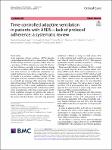Thông tin tài liệu
Thông tin siêu dữ liệu biểu ghi
| Trường DC | Giá trị | Ngôn ngữ |
|---|---|---|
| dc.contributor.author | Stephan, Katzenschlager | - |
| dc.contributor.author | Christoph M., Simon | - |
| dc.contributor.author | Patrick, Rehn | - |
| dc.date.accessioned | 2023-03-23T01:46:17Z | - |
| dc.date.available | 2023-03-23T01:46:17Z | - |
| dc.date.issued | 2023 | - |
| dc.identifier.uri | https://link.springer.com/article/10.1186/s13054-023-04340-w | - |
| dc.identifier.uri | https://dlib.phenikaa-uni.edu.vn/handle/PNK/7076 | - |
| dc.description | CC BY | vi |
| dc.description.abstract | Acute respiratory distress syndrome (ARDS) describes a polyetiological clinical picture characterized by diffuse alveolar damage and acute respiratory failure which has a prevalence of 10% in intensive care units [1]. One factor that influences mortality is the ventilatory strategy in invasively ventilated ARDS patients. Since the ARMA trial, there has been no multicenter randomized controlled trial that has been able to assign further mortality benefit to a particular ventilatory strategy [2]. The main goals of invasive ventilation strategies are to ensure an acceptable gas exchange while preventing ventilator-induced lung injury (VILI) therefore buying time for the lung to heal [3] | vi |
| dc.language.iso | en | vi |
| dc.publisher | Springer | vi |
| dc.subject | Acute respiratory distress syndrome | vi |
| dc.subject | ventilator-induced lung injury | vi |
| dc.title | Time-controlled adaptive ventilation in patients with ARDS—lack of protocol adherence a systematic review | vi |
| dc.type | Book | vi |
| Bộ sưu tập | ||
| OER- Y học- Điều dưỡng | ||
Danh sách tệp tin đính kèm:

